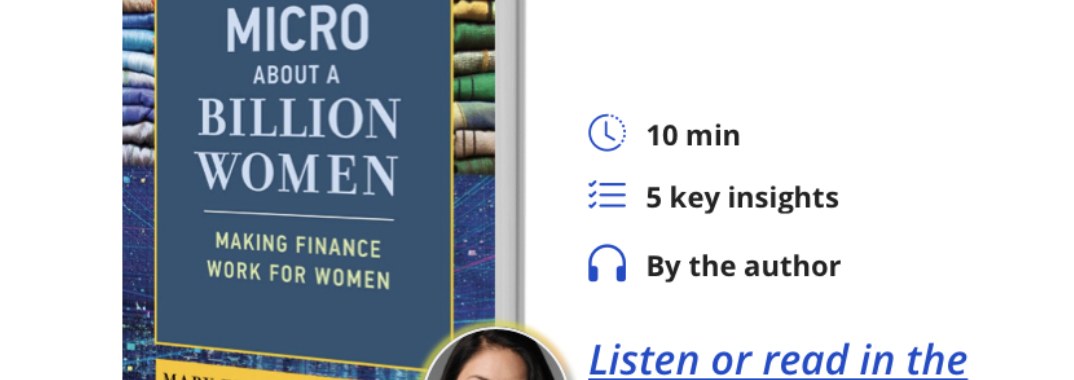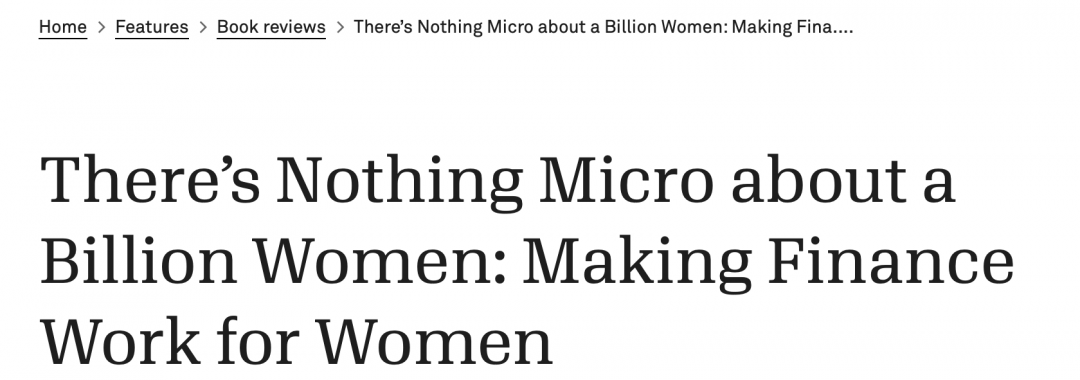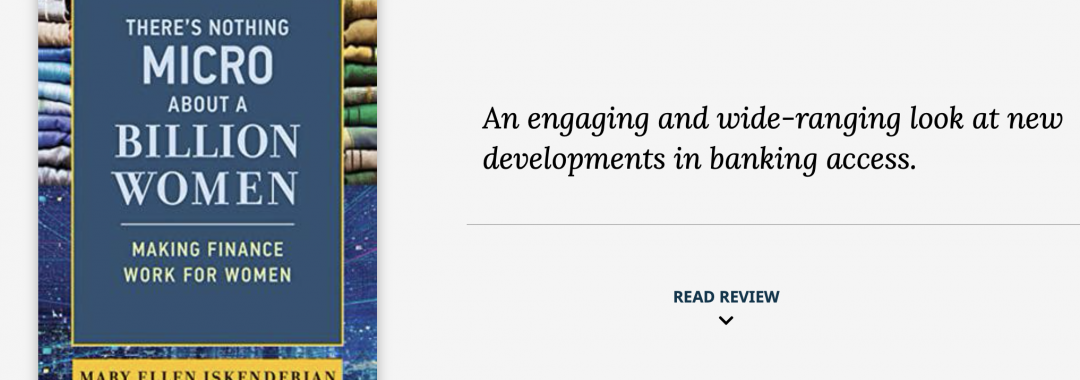Despite the large number of financial transactions that take place on a daily basis, nearly a billion women around the world are still excluded from the financial system—and opportunities to gain financial independence. Ensuring equality of access to financial services would offer life-changing prospects for women.
In There’s Nothing Micro about a Billion Women: Making Finance Work for Women, Mary Ellen Iskenderian examines how financial inclusion could be instrumental to women’s financial independence and empowerment. The author uses her professional experience in the banking sector as well as academic research, case studies, and stories to illustrate the benefits of women’s financial inclusion and steps stakeholders need to take to eliminate gender-based barriers. Iskenderian points out that the advantages of closing the gender gap in financial services go beyond the life of the individual woman: It improves the lives of her family members and strengthens the community and the national economy. The author makes the case for women’s inclusion as a business strategy for financial service providers to add an underserved market to their portfolio.
Iskenderian notes that her experience working in the banking sector taught her how access to financial services could make a difference in the lives of low-income women. She tells the story of a woman entrepreneur who overcame numerous obstacles to secure loans to start and expand her business and became a successful business owner with many employees. Her success and financial stability allowed her to provide for her family, invest in her children’s education as a means to secure their future, and play a prominent role in her community. As Iskenderian writes, “improving a woman’s financial access brings with it an intergenerational multiplier effect that leads to consistently better outcomes in the health, education, and lifelong earning potential of every member of her entire family, including both boys and girls.”
There’s Nothing Micro about a Billion Women is divided into two parts. In the first part, the author provides background information on the gender financial gap, lists obstacles that women face in being fully included in the financial system, and promotes financial inclusion as a means to women’s empowerment and agency. In the second part, she invites financial service providers to view low-income women as a rewarding customer base, encourages stakeholders and policy makers to create the necessary conditions that would foster efforts to improve women’s financial inclusion, and offers recommendations for how to achieve it.
An interesting feature of this book is that Iskenderian starts by cataloguing the different options low-income people and women have been using to save over time, from informal systems such as hiding money under the mattress, forming saving clubs, and borrowing money from pawnbrokers, to formal financial services such as joining credit cooperatives or microfinance institutions. Despite their many disadvantages—most are costly and inconvenient and don’t pay interest—these options demonstrate the need for financial products and the importance of savings for these individuals. As the author states, “every man and woman, no matter how poor, needs the means to make and receive payments, as well as a safe place to store funds. The needs to accumulate remains a constant throughout life.” The financial system could adopt some of the informal financial services models and tailor their financial products to meet the needs of low-income people, especially women, who are currently underserved by this market.
What are the features that are most appealing to low-income women in a financial product? Iskenderian’s stories and case studies demonstrate that women are looking for reliability, convenience, confidentiality, and trust, among other criteria. As the author notes, lack of access to identification documents and lack of property ownership as collateral are barriers that make many women ineligible to open a bank account or apply for a loan, while lack of financial and digital literacy presents additional obstacles. Women also face gender bias when requesting a loan.
In addition to those systemic issues, most banks do not disaggregate their data at the gender level and fail to understand the different types of products and services required by each customer segment. Iskenderian calls on the banking sector to disaggregate data to better understand the needs of and reach women customers by taking into consideration the barriers women face when designing their products and services. For example, banking product should include an educational tool that helps increase awareness and financial literacy.
Iskenderian expands her analysis by exploring the role of access to technology in closing the gender gap in financial access. Low-income people don’t have enough money to maintain a bank account, which sometimes requires a minimum balance or charges monthly fees. With advances in technology and increased use of smartphones, digital financial services have been helping to expand access for women and narrowing the gender financial gap. Mobile money providers can offer small transactions at low cost, even for people in remote areas, which make them a great option for women.
“Countries with a higher percentage of people without bank accounts have higher mobile money penetration,” Iskenderian writes. Given that many women in developing countries do not have access to a phone of their own, she also encourages greater inclusion in access to mobile internet technology. Mobile apps should also be more user-friendly so illiterate users can also use them.
Not only will gender financial inclusion lead to more visibility, more empowerment, and more agency for women and, in turn, benefit the broader society, but underserved women also represent a good business opportunity for financial institutions, the author argues: “In this moment of reinvention, when the future is very much up for grabs, there is a compelling argument for banks to capitalize on these new levels of trust and actively embrace financial inclusion.” Iskenderian cites a 2020 report by Oliver Wyman showing that financial service providers are missing out on at least $700 billion in revenue each year by not serving women customers. Ignoring gender-specific data and not tailoring their offerings to women can be costly for banks, she writes. Although it could be challenging to bring underserved women into the market, banks should learn to manage the risk and adapt their products and services to meet women’s needs.
The book concludes with actionable recommendations for stakeholders, including policy makers, the banking system, and technology actors. Policy makers must start by removing the systemic barriers women face. Governments must understand that policies should not be gender-neutral and that women financial inclusion is key to social and economic development. Researchers should disaggregate data about women from household data to better understand their needs. Mobile money providers should continue to encourage financial inclusion by expanding the number of cash-in/cash-out points to more convenient locations and include more women agents, who have been proven to be proficient in establishing trust with customers.
In this book, Iskenderian raises the everlasting issues of our time: inclusion and gender equality—which have compelled more attention recently. She makes convincing arguments to encourage policy makers and the financial system to rethink financial inclusion as a fundamental element to achieving gender parity. There’s Nothing Micro about a Billion Womenoffers real-life examples, case studies, and research that demonstrate how stakeholders can come together to create a more gender-inclusive financial system, which would deeply affect the lives of many women around the world—and communities and economies—for the better.


